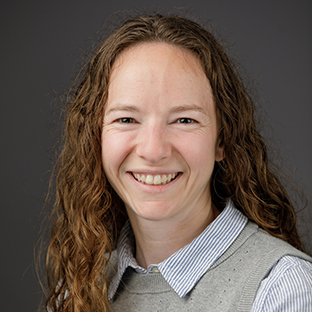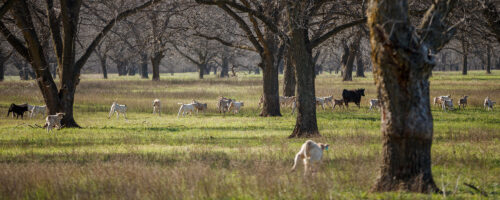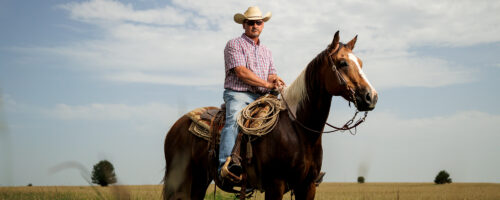Seeing is Believing
Three of our ranch management team members open up about the regenerative practices they’re investing in on their home ranches.
Nearly every person on our ranch management team grew up ranching under conventional practices. For generations, these ranchers followed a tried-and-true business model that relies on expensive inputs and a few long days in a tractor each year to make hay. Adapting a different way of doing things on the Noble Ranches was one thing. But three years later, Noble’s ranch managers are integrating regenerative practices on their home ranches as well — and it’s paying off.
Since 2021, Noble’s ranch managers have had the opportunity most don’t — they get to answer the question, ‘What would happen if I tried (insert practice here)?’ With no risk to their bottom line, they’ve watched the benefits of regenerative ranching unfold in real time on Noble’s 13,500 acres of grazing land. Now three ranchers from Noble’s ranch staff share how they’ve evolved their mindset, and land management, at home in the last few years.
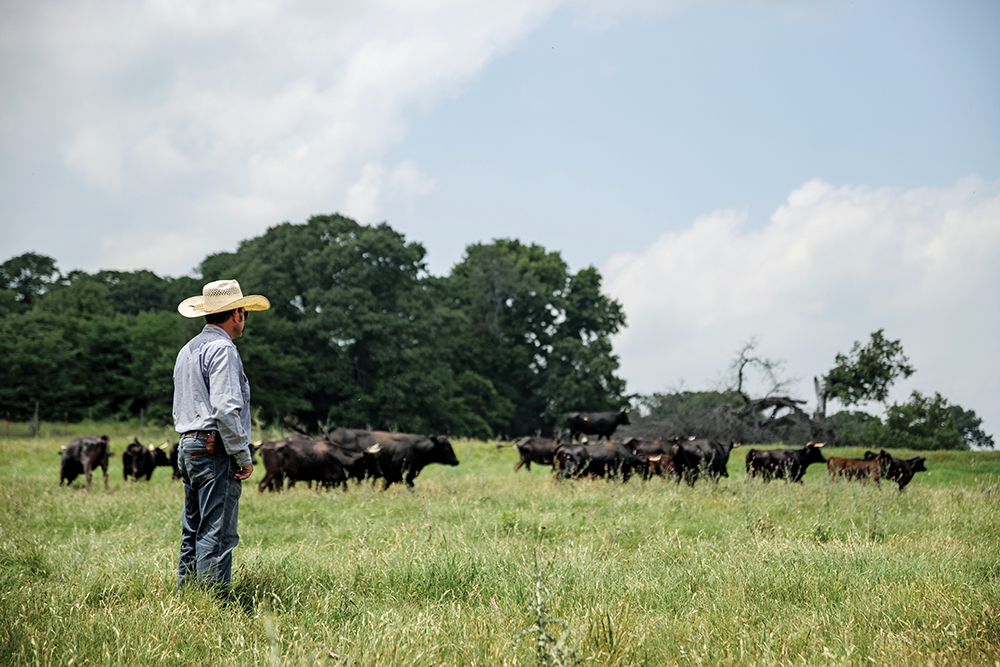
A Long History on the Land
CHANCE TYNES, RANCH FACILITY MANAGER
Chance Tynes is the ranch manager at Noble’s 5,169-acre Oswalt Ranch. But long before his employment with Noble, Tynes learned the industry through hard work at home. His family owned a ranch where his mother operated a beauty shop, and his father ran cattle. Despite his disinterest in the cattle business after college, Tynes found his way back to his roots through his passion for roping. “I was involved in the rodeo business back then. So, I bought some roping cattle to keep my horse’s legs up and keep our practice involved,” explains Tynes. A few Corriente cattle turned into a small herd, leading Tynes and his father back into the cattle business.
Today, father and son manage around 650 acres and run a little more than 100 cows across several tracts of land. Two years ago, Tynes started incorporating regenerative practices on his land. His first order of business: water access.
“I built a pond here about three years ago in one corner of the ranch, and I laid about 1,000 feet of water line so I could sort those cows off and have water in all corners of the pastures,” says Tynes. Updating his water access was step one. But he isn’t done there; when he’s able, he plans to invest in more fencing for smaller pastures.
Some of the land and cattle he manages on his own, while other herds and pastures are managed in partnership with his father. It’s a business dynamic that’s created some challenges as the younger Tynes continues to incorporate regenerative principles on his land.
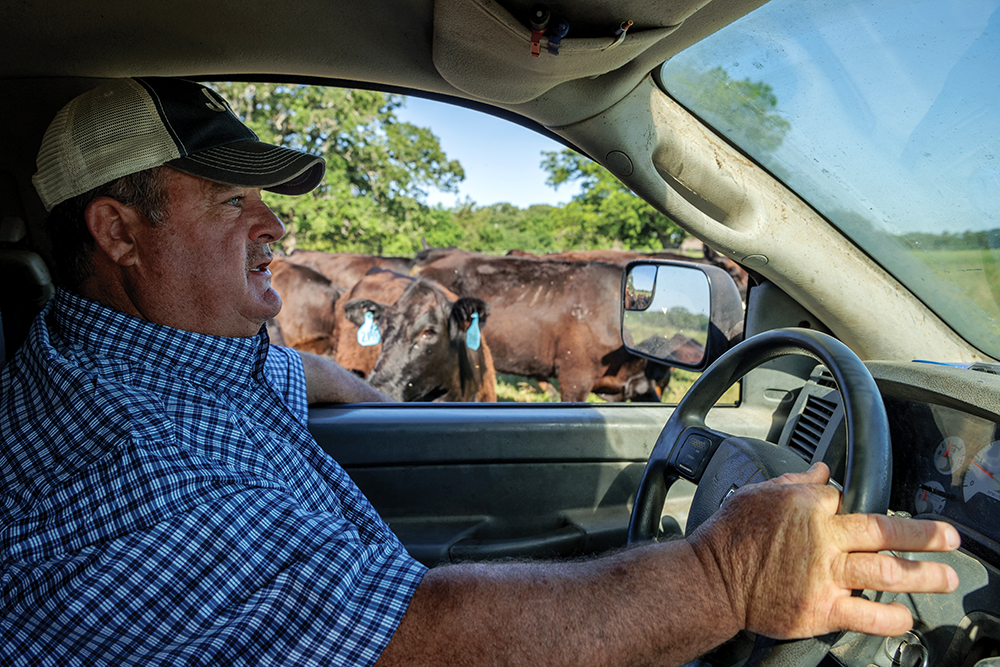
JON WILLIS, RANCH FACILITY ASSISTANT
he dynamic between multiple generations managing the same ranch isn’t foreign to Oswalt Ranch’s ranch assistant, Jon Willis.
His ranch, Willis Simmentals, has been in his family for nearly 100 years. His great-grandfather purchased the original 80 acres in the 1930s and built the house Willis and his family live in today. His grandfather expanded the ranch to 540 acres, which is now shared among his children and grandchildren.
“It will mean a lot to me because a lot of people can’t say that,” Willis says of the upcoming 100-year anniversary of the original 80 acres being in his family’s care.
The Willis family runs a seedstock operation, selling registered Simmental bulls, heifers and embryos. You can find their cattle across Texas, Oklahoma, Arkansas and beyond.
Before his grandfather passed away in 2000, he asked Willis for one favor. “My grandad always was aware and wanted to learn to do more for the land,” he recalls. “His last wish before he died in 2000 was ‘be good stewards of the land,’ and it stuck with me. I take that to heart, and that’s what I try to do.”
Two years ago, Willis started applying some regenerative grazing principles to his ranch. He knows his infrastructure is a limiting factor, but he’s finding his reliance on fertilizer is a generations-long crutch.
“All of our pastures were, at one time, farmed in cotton, peanuts or small grains, and there’s just not a lot of topsoil left,” he says of his challenge in transitioning to regenerative. When those fields were turned into pastures, they were sprigged with bermudagrass, which needs fertilizer to grow well in his shallow Oklahoma soil.
Last year, Willis put out less fertilizer and moved his herd more frequently than his usual rotational grazing pattern. True to his word to his grandfather, Willis is trying to do the best he can for the land. But he knows to keep moving further down the path of regenerative, he needs to create water access to every pasture.
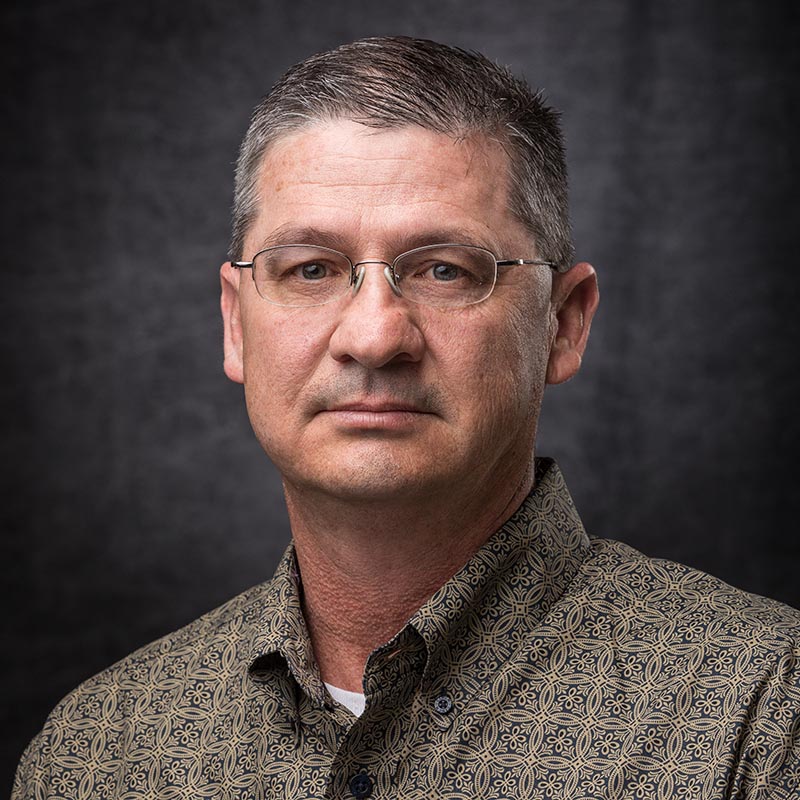
PAUL LUNA, RANCH FACILITY MANAGER
Taking care of the land is a sentiment that appeals to Paul Luna, too. He’s the ranch manager at Noble’s headquarters in Ardmore. He’s also managing land at home that was gifted to his family a generation ago by a family friend who helped raise his father.
Luna’s father managed the land as a dairy farm in the 1940s, then as a cattle ranch from the 1950s until the mid-2010s, when his health declined. Luna now manages the land and the cattle business. When he was growing up, the ranch was operated conventionally, with one or two large pastures. Today, things look a bit different.
“Now, since I took it over, I started making smaller fields,” says Luna of the changes he’s made to the ranch. “It’s not like we do it here at Noble. More like a two-week schedule, just because of having to work, then take care of my dad. I don’t get out as much as I want to.”
But he was searching for a better way to increase profitability on his land even before he joined the team at Noble.
“The last time I sprayed my grass for weeds, the bottom of the hose on my sprayer got hooked on something and pulled off. There was a lot of money draining into the ground. I was trying to capture it before it all ran out of the tank, and I ended up taking a shower in that spray. I thought, ‘Man, there’s got to be a better way.’”
That was in 2020, a year before Noble announced its mission to regenerate 164 million acres of grazing lands. At the time, Luna recalls searching online, not for regenerative agriculture, but for ways to run more cows on the same acreage. The search led him to some of the same practices used on Noble ranches today.
When Noble announced its transition to regenerative, Luna was already on board and eager to grow his skills through Noble’s direction. But some of his fellow ranch managers weren’t so sure this was the right path.
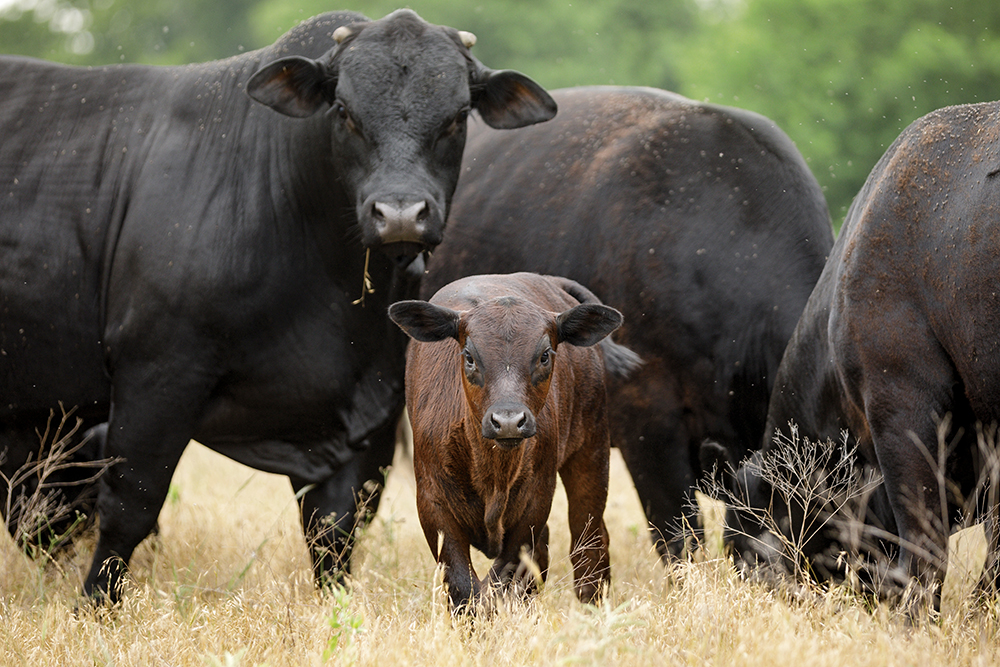
Winning Over Skeptics
Tynes recalls his first reaction to hearing Noble’s ranches would be transitioning from conventional to regenerative management.
“To be honest, I thought, well, if we don’t spray weeds and fertilize, we aren’t going to be in business very long,” he says. Besides reading about the idea in a few magazines, he didn’t know anyone who ranched that way.
It took Tynes some time to come around to the idea. He, like many ranchers, wanted to see the principles in action before considering changes to his ranch at home. Slowly, though, as he watched a system of management unfold before him, it started to make sense.
“I saw how it worked at (Noble), and I thought, I’m spending most of my profit on fertilizer, weed spray, stuff like that,” Tynes says. “My dad still believes in a bunch of that, but on my own places, I’m going to try to reduce my cow herds a little bit and have enough grass to go through the winter. I’ve seen that it already works better; you make more profit without all the inputs — even with half the cattle you can make more profit.”
Tynes admits there were some barriers for him at first. Instead of mowing and baling hay on part of his ranch, he wanted to split up his pastures to allow more rest between grazing.
“We’re just kind of getting started on the fencing stuff so we can start rotating really well and maybe get some grass that we can hold over for the wintertime.
I want to let everything grow up and have good rest periods between grazing. So, maybe we can do a better job there and not have to feed hay as much.”
Transitioning a bit at a time is what makes sense for Willis’ ranch, too. Philosophically between his peers at the time, he recognized some of the principles right away. But the term regenerative wasn’t something he used to describe his ranch.
“I never really thought of it regeneratively, but you know, when you cut hay, you’re robbing from the soil. So, we’ve always cut, then tried to go back and feed that hay to where we cut it, so that nutrition — the manure and the urine — goes back into that land.”
The soil on his ranch is typical of southern Oklahoma, marginal and always three weeks away from drought conditions. In 2009, Willis bought a bale processer to help build topsoil through organic matter. Instead of a concentrated feeding at one round bale, Jon broke down the bale into a windrow buffet, spreading out the impact of the cows over a length of pasture. Then he’d repeat the process in a series of rows until the entire field was naturally fertilized with leftover hay, and manure.
“For that part, I think I was ahead of my time, but we still fertilized,” Willis says. “But we’re trying to cut back, and doing the best we can with what we have.”
As a seedstock operation, raising cattle for genetic potential and selling registered bulls, he doesn’t have just one or two herds, but four. Which makes rotating and resting pastures more of a challenge.
“With four different groups of cows, it’s difficult to have enough fencing materials to (move each herd every day),” he explains. “So, I move them, maybe every three to four days.”
Noble’s philosophy — in business and ranching — is progress over perfection. Which is exactly how these ranchers are moving toward a regenerative model for their home ranches.
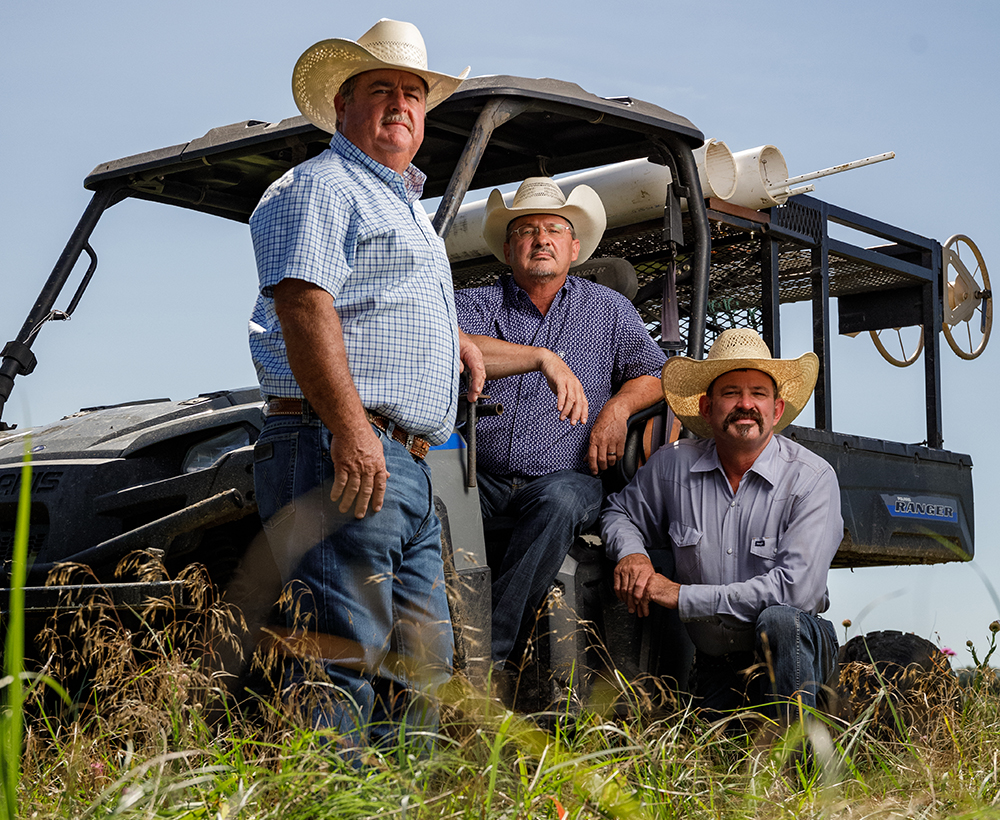
Better, for the Sake of the Land
All three men are working hard to leave the land better than they found it. Luna and Willis hope the next generation of their families decides to come back to the ranch, but they know keeping the land in agriculture is not a guarantee.
“I’ve got two kids, both boys. They help me when I have to work cattle, but they live in Oklahoma City and enjoy that life,” Luna says. But one of his sons has hinted at coming back to the ranch someday. If his son does return to ranching, Luna thinks he will carry on the methods he started. “He’s big into the environment, so he thinks what I’m doing really helps the land.”
Willis’ family is a bit younger, with a couple of daughters still living at home. But he knows there’s a chance his family ranch will be divided further between his generation and his children’s generation, making it harder to sustain a cattle business. The original 540 acres is already partially on lease from his aunt.
“It’ll be sad when that happens,” says Willis, “because I’ve spent basically 53 years on that property and it’s not mine, but it is mine. I do the best I can to steward the land and make it more productive and better each day.”
Still, he admits some hesitation about his children wanting to take over the ranch.
“It’s a hard living. I want them to go out and do better than what I’ve done. Times are good, but it’s a lot of hard work. It would be nice if one of them would, but I’m not going to push it on them now.”
Choosing to return to ranching and developing a natural passion for the cattle business is how Tynes started his enterprise. It’s one he’s looking forward to developing through regenerative practices.
“I really believe in the future of this ranch,” Tynes says. “If I keep dozing some trees off here and there, and opening some of it up, and graze adaptatively, I’ll be able to run a few more cows on it and not have so many inputs. My future plans are to make it work on very little inputs and a whole lot more outcome, and maybe I won’t have to work at a job one of these days.”
Every ranch is unique, and every rancher knows his or her land, cattle and business best. Incorporating regenerative practices is the right move for these three ranchers to realize their goals. Whether it’s to keep a promise to improve the land, feed a few more cattle on the same acreage, or earn a better return on their business, regenerative ranching opens new opportunities.
